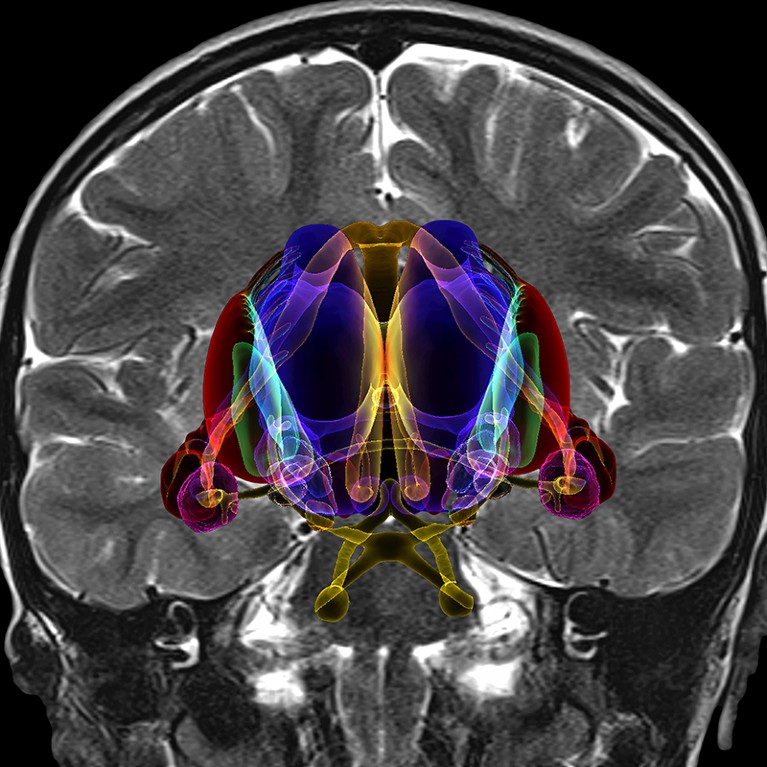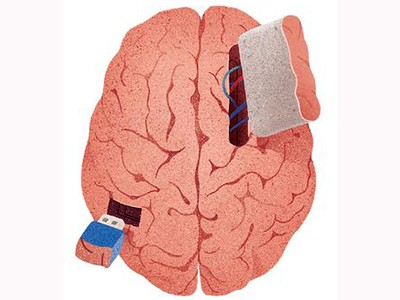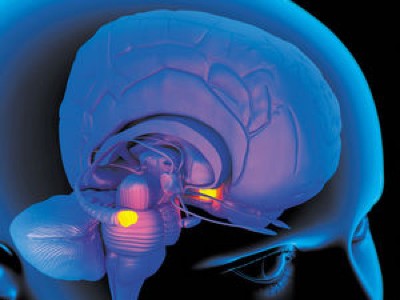
An illustration of the brain’s amygdalae (the pinkish purple structures at far left and far right), which have a role in non-conscious detection of threats and defensive behaviour.Credit: K H Fung/Science Photo Library
The Deep History of Ourselves: The Four-Billion-Year Story of How We Got Conscious Brains Joseph LeDoux Viking (2019)
There is a tradition for scientists of a certain age to write a book tackling grand topics about the human condition. Recently, such tomes have included biologist E. O. Wilson’s The Meaning of Human Existence (2014) and neuroscientist Antonio Damasio’s The Strange Order of Things (2017). In these ‘big picture’ studies, scientists stretch beyond their areas of expertise to try to answer the question of what it means to be human. Psychologists become physiologists. Biologists become psychologists. Neuroscientists become anthropologists. And everyone’s a philosopher.
The Deep History of Ourselves, neuroscientist Joseph LeDoux’s latest book, sits within this tradition. The book lays out a bold extension of his decades-long scientific journey in the study of survival behaviours in humans and other mammals.
LeDoux, an academic at New York University in New York City, is best known for his research on fear, and for carefully mapping the brain circuit centred on the amygdala — a knot of neurons in the medial temporal lobe. The amygdala, he showed, has a crucial role in non-conscious, defensive behaviour responses such as freezing or fleeing. His conclusion, based on the assumption that all mammalian amygdala circuits are structurally similar, was that all mammals (including humans) share these responses. He described this work in The Emotional Brain (1996).
In the meantime, the amygdala circuit was referred to as the ‘fear circuit’. This became problematic. The mislabelling, LeDoux realized, had fuelled a misconception: that humans and other mammals share the conscious experience of fear (that is, the feeling of fear), not just non-conscious, defensive behaviours. In fact, he has long argued that, on evidence, the amygdala circuit is not sufficient, and might not be necessary, for feeling fear; that role, he suggests, is filled by parts of the prefrontal cortex involved in working memory.
To deal with these confusions, LeDoux recast amygdala circuits as ‘survival circuits’ that give rise to survival-related behaviours such as defence, eating, temperature regulation and reproduction. And he reserved the term ‘fear’ only for the conscious experience of fear. This new view was outlined in his book Anxious (2015).
In The Deep History of Ourselves, LeDoux takes the next step. He proposes an entire taxonomy of survival behaviours and their putative neural circuits. These behaviours range from obligatory reflexes (such as being startled by a loud noise) to more flexible, goal-directed actions (such as anticipating and avoiding a possible threat). The book is an epic tale, tracing the evolution of survival behaviours from the dawn of life on Earth 3.8 billion years ago, to the development of the human brain’s capacity for consciousness, language and culture.
LeDoux begins the book with a crash course in evolution. He explicates how inorganic matter gave rise to organic life through replication or the development of metabolic processes; how single-celled organisms coalesced into multicellular creatures through one cell engulfing another; and how those creatures eventually developed the capacity to reproduce sexually, grow neurons and develop bodies with nervous systems. He weaves a convincing narrative of science and speculation to conclude that the roots of human behaviour are more ancient that we realize. “Cellular features underlying behaviors we often associate with brains,” he writes, “in fact existed billions of years before the appearance of nervous systems.”
Once a nervous system was in place, LeDoux explains, brains quickly evolved. He uses the rest of The Deep History of Ourselves to sketch a natural history of brains as they developed the capacity to create the elements of the human mind, focusing mainly on the emergence of emotions, memory and consciousness. As the narrative tumbles from one topic to another, it remains a steady meditation on survival. Throughout nearly 400 pages, LeDoux makes a case for the role that day-to-day human actions — from simple movements to conscious remembering and deliberating — have in biological survival.
LeDoux is at his best when thoughtfully considering some of neuroscience’s more contentious topics. He revisits the question of consciousness in non-human animals, concluding that if it exists, it is very different from our own. He muses on why some scientists place humanity at the apex of intelligence on Earth, and mistakenly assume that evolution aimed itself at us. And he offers terrific examples of how the assumption of such a natural order in evolution (scala naturae, the idea that living things have a linear order, from simple to complex) is profoundly unhelpful to scientific progress.
For example, many scientists still assume that emotions are a legacy of some ancient mammalian ancestor, and that they lurk in subcortical circuitry which has supposedly remained largely unchanged by evolution. LeDoux explains how this view leads otherwise gifted researchers to wrongly believe that when humans and non-human animals perform similar actions, these are accompanied by similar feelings — the same anthropomorphism that led him to redraw the map of fear. He concludes that such magical thinking has interfered with the search for medications to treat anxiety disorders, which now affect a record high of hundreds of millions of people globally.
Like all such sweeping treatments, The Deep History of Ourselves offers one grand narrative of how humans got conscious brains. LeDoux surveyed the relevant data and gives us his best take of how things work. Many topics of debate pass unmarked, so every scientist will probably find something to disagree with.
For example, LeDoux considers the embryological development of different organisms to infer their ancestral relationships. That is current best practice. But he also states that our 580-million-year-old common ancestor (the protostome–deuterostome ancestor, or PDA) had a brain — a claim that is highly debatable. (Deuterostomes such as the cephalochordate amphioxus, a small fish-like invertebrate, have a small group of neurons at their anterior end, but these lack the organization found in vertebrate brains.)
Learning through classical or Pavlovian conditioning seems to be universal across the animal kingdom, a view supported by available evidence. LeDoux writes, however, that some animals achieve it by mere association because they lack any capacity to recall the past and plan for the future. This is unlikely: even some single-celled organisms ‘remember’ and predict chemical conditions that occur minutes or hours later.
LeDoux also suggests that some survival behaviours (such as the startle response) issue from reflexes, an inference supported by evidence. But he describes reflexes as obligatory, stereotyped responses that are independent of context, and that conflicts with evidence from behavioural ecology.
To focus on such objections, however, is to miss the larger point. The Deep History of Ourselves is not a comprehensive review of any scientific topic. It is a curated tour: a window into one distinguished scientist’s beliefs about what is important and true. Its scope is broad, yet it contains enough detail for an engaging storyline. It offers thoughtful insights that linger over time. It is, in short, an admirable effort from one of this generation’s most important neuroscientists.



 Origin of life: The first spark
Origin of life: The first spark
 The mechanics of mind
The mechanics of mind
 Inside the fear factor
Inside the fear factor






